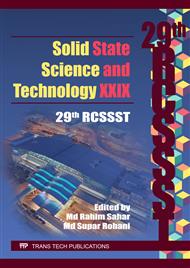[1]
Tanabe, S., Hirao, K. and Soga, N. (1990). Upconversion Fluorescences of TeO2- and Ga2O3-based Oxide Glasses Containing Er3+. J. Non-Cryst. Solids. 122, 79-82.
DOI: 10.1016/0022-3093(90)90228-e
Google Scholar
[2]
Oz, B. (2006). Thermal Microstructural and Optical Characterization of TeO2-K2O Glasses. Editor. M. Sc. Thesis, Istanbul Technical University.
Google Scholar
[3]
Wang, J. S., Vogel, E. M. and Snitzer, E. (1994). 1. 3µ Emission of Neodymium and Praseodymium in Tellurite-Based Glasses. J. Non-Cryst. Solids. 178, 109-113.
DOI: 10.1016/0022-3093(94)90273-9
Google Scholar
[4]
Giri, N.K., A.K. Singh, and S.B. Rai, Efficient Blue Upconversion Emission in Tm 3+ via Energy Transfer from Yb 3+ doped in Lithium Modified Tellurite Glass. J. Appl. Phys., 2007. 101: p.033102.
DOI: 10.1063/1.2432305
Google Scholar
[5]
Ghoshal, S.K., et al., A Model for Enhanced Up-Conversion Luminescence in Erbium-doped Tellurite Glass Containing Silver Nanoparticles. Adv. Mat. Res., 2012. 501(61-65).
DOI: 10.4028/www.scientific.net/amr.501.61
Google Scholar
[6]
Awang, A., et al., Enhanced Spectroscopic Properties and Judd–Ofelt Parameters of Er-doped Tellurite Glass: Effect of Gold Nanoparticles. Current Applied Physics, 2013. 13(8): pp.1813-1818.
DOI: 10.1016/j.cap.2013.06.025
Google Scholar
[7]
Sekiyama, A., et al., The Prominent 5d-Orbital Contribution to the Conduction Electrons in Gold. New. J. Phys., 2010. 12: p.011101.
Google Scholar
[8]
Kesavulu, C.R., et al., EPR, Optical, Photoluminescence Studies of Cr3+ Ions in Li2O–Cs2O–B2O3 Glasses – An Evidence of Mixed Alkali Effect. J. Mol. Struct., 2010. 975: p.93.
DOI: 10.1016/j.molstruc.2010.03.091
Google Scholar
[9]
Rani, S., S. Agarwal, and N. Ahlawat, Influence of Bi2O3 on Optical Properties and structure of Bismuth Lithium Phosphate Glasses. J. Alloys Compd., 2009. 477(504-509).
DOI: 10.1016/j.jallcom.2008.10.048
Google Scholar
[10]
Z.A. Said Mahsur, et al.
Google Scholar
[11]
Jorgensen, C.K., Modern Aspect of Liggand Field Theory. North-Holland, Armsterdam, (1971).
Google Scholar
[12]
Zarifah, N.A., et al., Magnetic Behaviour of (Fe2O3)X (TeO2)1-X Glass System due to Iron Oxide. Chalcogenide Letters, 2010. 7: pp.565-571.
Google Scholar
[13]
Xy, S., et al., Optical Transitions and Upconversion Mechanisms in Er3+-doped Heavy Metal Oxyfluoride Germanate Glass. J. Alloy. Comp., 2004. 377(1-2): pp.253-258.
DOI: 10.1016/j.jallcom.2004.01.030
Google Scholar
[14]
Rolli, R., et al., Erbium-doped Tellurite Glasses with High Quantum Efficiency and Broadband Stimulated Emission Cross Section at 1. 5 lm. Opt. Mat., 2003. 21: pp.743-748.
DOI: 10.1016/s0925-3467(02)00092-7
Google Scholar
[15]
Sousa, N.C.A.D., et al., The Role of TiO2 in the B2O3–Na2O–PbO–Al2O3 Glass System. J. Solid State Chem., 2011. 184: pp.3062-3065.
DOI: 10.1016/j.jssc.2011.09.011
Google Scholar


